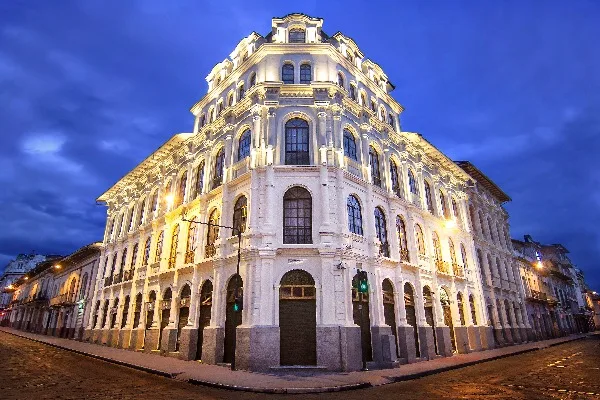Museo Pumapungo is Cuenca’s biggest museum and also its best; tip: don’t miss the shrunken head collection
Sometimes the biggest is also the best and in the case of museums in Cuenca, Museo Pumapungo del Ministerio de Cultura proves the rule. From portraits to ponchos, from 50,000-sucre bills to shrunken heads, Cuenca’s most extensive and impressive artistic, historical, cultural, and ethnological exhibits are housed on three floors in a large wing of the Central Bank.
You sign in at the front desk, where you leave your bag and are instructed not to take photographs or to step over the yellow tape in front of the exhibits (which sets off a recording and draws security). Also, all the signs, except for the Shuar exhibit, are in Spanish.
sets off a recording and draws security). Also, all the signs, except for the Shuar exhibit, are in Spanish.
Then it’s on to the collection of fine art displayed off the lobby on the middle level of the museum. The first room is dedicated to typically exquisite sacred and religious paintings, sculpture, and figurines, including an ornate Nativity scene.
In the next room hang retratos (portraits) of heroes of Ecuador and Cuenca: Símon Bolívar and José de Sucre; Abdon Calderón, after whom Cuenca’s central plaza is named; Juan Montalvo, Luis Cordero, and Benigno Malo; and priests such as Frederico Gonzalez Suárez and Padre José Maria Aguirre. It’s fun and instructive to see the namesakes of some of the busy streets in Cuenca’s El Centro.
In the last of the lobby rooms are landscape paintings of Cotapaxi, Tungurahua, and the Oriente, scenes of indigenous people and customs, and vividly colorful folk art.
The Coins of the Realm
Downstairs is a comprehensive display of the history of money in Ecuador. The various currencies are the aboriginal shells and beads used for trading among the pre-colonial natives. The first coins of the Spanish era, irregularly shaped chunks of flat silver, date back to the mid-1600s. The coins on display from the mid-1700s are more uniform in size, shape, and silver content.
The first Ecuadorian money was introduced in the 1830s, and numerous samples of the currency of the young republic are on display. In the 1840s, coins were produced with gold as well as silver and by the 1850s, the designs were noticeably more sophisticated. Nickel-silver alloys were used starting in the 1890s and copper was added to the gold and silver in the 1920s. By 1972, all the coins were made of nickel.
The era of paper money was launched in the late 1800s with the emergence of a more centrally managed fiscal system. On display are early sucres in 1, 2, 5, 10, and 100 denominations. A 500-sucre bill dates from 1928; a year later, the first 1,000-sucre bill was printed by the Banco Central. The denominations kept rising until, in 1995, the 50,000-sucre note was released. That sounded the death knoll for the sucre, which was inflated out of existence in 1999, where the numismatic exhibit ends.
The Ethnographic Exhibits
You can spend at least an hour examining the art and money, but the best part of the museum is yet to come.
The ethnographic exhibits encompass the mainstream Ecuadorian culture and the 22 indigenous ways of life. Greeting you on the upper floor is a nine-piece band of full-size mannequins and musical instruments. The music theme continues with drums and antique instruments, then leads to displays on the rodeo, masks, pottery, games, and ponchos. The diorama of a ceremonial parade at night is especially intriguing — and a little spooky.
You might start to go a little numb wandering through the little scenes displaying carvings, ceramics, textiles, boxes, baskets, wicker furniture, and more pottery, including a couple of huge water containers five feet tall and three feet wide, with a full-size firing kiln on display next to them. You might go numb just reading about it all.
But then you’re delivered to the well-publicized highlight of Museo Pumapungo: the Shuar exhibit. This wing of the floor is special for two reasons. One, it boasts the only bilingual information; plastic signs have a faceplate that slides over the Spanish, revealing the English. And second, the shrunken heads.
You read about the Shuar uses of tobacco, fasting and abstinence, shamanism, blood rituals including the religious sacrifice of pigs and face-painting with rooster blood, and the ritual aspects of warriors and intertribal raids, which lead into the tsantsa displays.
The Shrunken Head Business
The decapitation of enemy dead and various uses of the heads have been common throughout history. But the practice of shrinking them is unique to the Amazon’s northwestern rain forest and the Shuar were its main practitioners. Their word for it was tsantsa.
The Shuar took heads, then put them through the shrinking process. When the practice began is lost in the mists of history, but it’s known that it was a ritual to harness the spirit of the enemy. First, the back of the neck was sliced open and the brains were scraped out. A wooden ball was used to retain the shape, then the whole head was boiled in tannin-infused water till it was reduced to the ultimate size: a little larger than a man’s fist. At the end of the process, the holder of the head had not only conquered the body, but also vanquished the soul; by this seemingly extreme housebreaking ritual, the enemy’s soul was prevented from avenging its death.
Five heads are on display and they’re mighty gnarly, known for oversized jaws, other facial distortions, and sunken sides of the forehead. But that didn’t prevent commercial interests from overtaking the religious significance, which is when the heads became a commodity. From around the 1870s through the 1940s, this part of Ecuador and Peru was known for its “headhunters” who killed to satisfy the collector demand. But that’s another story. According to the experts, the last head was shrunk in the early 1960s.
The Rest of the Museum
The upper floor also houses exhibits of the other native Ecuadorians, the Cofan, Saraguros, Cañaris, Chimbos, Otovaleños, Montuvios, and Chachi Cayapas among them.
The Museo Pumapungo definitely requires at least two visits; by the time you get through the Shuar, your head feels like it’s been through the shrinking process. Doing all three floors in one tour is a good way to turn into a museum zombie.
There is also a temporary exhibit at the museum in a small room beyond the staircase on the upper level. Currently on display is the artwork of the Tigua people, who live at 3,200-4,000 meters in the mountains west of Latacunga and Mt. Cotopaxi. Tigua artists are renowned for the use of vibrant colors for their decorations of traditional masks, drums, and sheepskin canvases. On display are drums, paintings depicting pastoral life, religious ceremonies, and cultural festivals, and decorated clothing; a video documents the artistic process.
On the third floor is the research library where you can sit at tables in front of big picture windows and look out over the Cañari ruins of Pumapungo. There is also a small gift shop where you can buy Spanish-language books on history, architecture, art, politics, finance, and botanica, along with a few souvenirs.
Museo Pumapungo del Ministerio de Cultura is located at the east end of Calle Larga on the corner of Huayna Capac; open Mon.-Fri. 8-5:30, Sat. 9-1, Sunday, closed; free.
Credit: Reposted from the Miami Herald International Edition, July 29, 2011; Photo caption: a shrunken head at Museo Pumapungo.
















